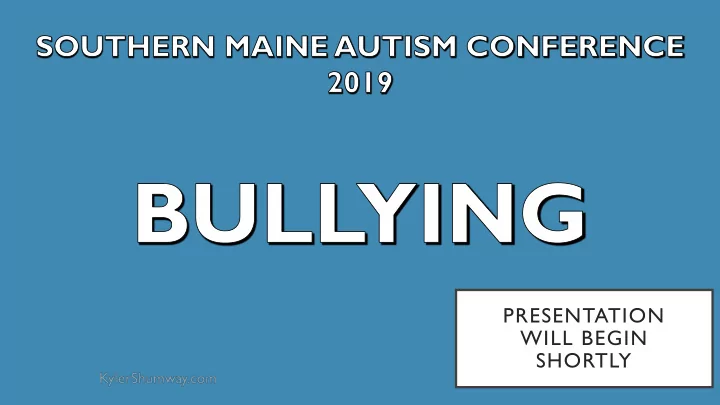

PRESENTATION WILL BEGIN SHORTLY
WERE YOU BULLIED?
25-35 % are bullied Currie et al., 2012; Espelage & Swearer, 2003; Vaillancourt, Trinh, et al., 2010).; Cassidy, 2009; Dulmus, Sowers, & Theriot, 2006; Kes- sel Schneider, O’Donnell, Stueve, & Coulter, 2012; Nansel et al., 2001; Perkins, Craig, & Perkins, 2011; Peskin, Tortolero, & Markham, 2006; Zablotsky, B., Bradshaw, C. P., Anderson, C. M., & Law, P. (2014).
ODDS OF BEING TARGETED 5.6x 4x 1.6x Kids on Average Friendless Autistic Traits Autistic + Friendless Currie et al., 2012; Espelage & Swearer, 2003; Vaillancourt, Trinh, et al., 2010).; Cassidy, 2009; Dulmus, Sowers, & Theriot, 2006; Kes- sel Schneider, O’Donnell, Stueve, & Coulter, 2012; Nansel et al., 2001; Perkins, Craig, & Perkins, 2011; Peskin, Tortolero, & Markham, 2006; Zablotsky, B., Bradshaw, C. P., Anderson, C. M., & Law, P. (2014).
ODDS OF BEING THE BULLY 2.5x 2x Kids on Average Hyperactive Autistic Low IQ Home issues Violent Farrington, D., & Baldry, A. (2010). Individual risk factors for school bullying. Journal of aggression, conflict and peace research, 2(1), 4-16.Currie et al., 2012; Espelage & Swearer, 2003; Vaillancourt, Trinh, et al., 2010).; Cassidy, 2009; Dulmus, Sowers, & Theriot, 2006; Kes- sel Schneider, O’Donnell, Stueve, & Coulter, 2012; Nansel et al., 2001; Perkins, Craig, & Perkins, 2011; Peskin, Tortolero, & Markham, 2006; Zablotsky, B., Bradshaw, C. P., Anderson, C. M., & Law, P. (2014).
OUR AGENDA FOR TODAY INTRODUCTION THE DISEASE THE REMEDY THE CURE
THE DISEASE
FOUR FORMS OF BULLYING PHYSICAL VERBAL SOCIAL CYBER
FOUR FORMS OF BULLYING PHYSICAL VERBAL SOCIAL CYBER
BULLYING HAS EVOLVED
WHO?
THREE TYPES OF BULLIES
THE CRAB KylerShumway.com
THE SHARK KylerShumway.com
THE CODFISH KylerShumway.com
WHY?
THE TWO THINGS BULLIES GAIN POWER RELIEF
THEIR GAIN = YOUR LOSS
Head Hands Heart
IT MAKES YOU FEEL ALONE KylerShumway.com
1. Bullying has evolved KEY 2. Not all bullies are the same POINTS 3. Bullying changes people
OUR AGENDA FOR TODAY INTRODUCTION THE DISEASE THE REMEDY THE CURE
HOW TO HEAL
1.Trace it back to memories Head 2. Seek evidence for and against 3. Experimental challenge
1. Become aware Heart 2. Understand why 3. Give the gift of forgiveness Flanagan, K. S., Hoek, K. K. V., Ranter, J. M., & Reich, H. A. (2012). The potential of forgiveness as a response for coping with negative peer experiences. Journal of Adolescence , 35 (5), 1215-1223.
1. Take care of your body Hands 2. Take care of your mind 3. Take care of your relationships
Head THERAPY! Hands Heart
HOW TO DEAL
Game plan Respond IF YOU ARE BEING TARGETED Team up
Have a game plan Safety IF YOU ARE BEING TARGETED Strategy Supports
Respond 1.Be the Sponge IF YOU ARE BEING TARGETED 2. Collect Evidence 3. Strategic Retreat
Team Up IF YOU ARE BEING TARGETED
Game plan Respond IF YOU ARE BEING TARGETED Team up
PARENTS AND PROFESSIONALS ASK GIVE CONTROL COLLABORATE Holt, M. K., Kaufman Kantor, G., & Finkelhor, D. (2008). Parent/child concordance about bullying involvement and family characteristics related to bullying and peer victimization. Journal of School Violence , 8 (1), 42-63. Borowsky, I. W., Taliaferro, L. A., & McMorris, B. J. (2013). Suicidal thinking and behavior among youth involved in verbal and social bullying: Risk and protective factors. Journal of adolescent health, 53(1), S4-S12.
BYSTANDERS
THREE WAYS TO INTERVENE DIRECT INVITATION FOR DO NOTHING CONFRONTATION CONNECTION
DIRECT CONFRONTATION PROS CONS • May escalate situation • Immediate aid • You may become a target • Disruption • Bully’s hurt is increased • Target is supported
INVITATION TO CONNECTION PROS CONS • Target may not accept • Nonconfrontational • Bully may pursue • Indirect disruption • Target is safe
TRY TO DO BOTH DIRECT INVITATION FOR CONFRONTATION CONNECTION
1. Healing is possible KEY 2. Have a plan, prioritize safety POINTS 3. Don’t be a codfish
THE CURE
AN EYE FOR AN EYE MAKES THE WHOLE WORLD BLIND
THE PROBLEM Harms Bully Target
THE DISEASE Suffering Bully Target Loss Abuse Neglect Harms
• Parental kindness and connectedness Attachment • Quality friendships • Sibling support • Prosocial friends Modeling • Low reactivity and criticism of others • Family engagement in prosocial activity • Treatment for emotional and behavioral issues Intervention • Coping strategies • Support for school interventions
Attachment LOVE and Modeling KINDNESS Intervention
THE CURE LOVE and COMMIT to KINDNESS
“In conclusion, there is no conclusion to what children who are bullied live with. They take it home with them at night. It lives inside them and eats away at them. It never ends. So neither should our struggle to end it .” - Sarah Hymel, S., & Swearer, S. M. (2015). Four decades of research on school bullying: An introduction. American Psychologist , 70 (4), 293.
THIS IS OUR MISSION
Stay Connected! KylerShumway.com ImproveYourSocialSkills.com The Friendship Formula (Chapter 14 is all about bullying!) Q&A
DO VIDEO GAMES CREATE BULLIES? • No - but early exposure (ages 8 and under) to violent videogames has been found to be related to decreased prosocial behaviors • Coyne, S. M., Warburton, W. A., Essig, L. W., & Stockdale, L. A. (2018). Violent video games, externalizing behavior, and prosocial behavior: A five-year longitudinal study during adolescence. Developmental psychology , 54 (10), 1868. • No link between actual bullying/violence IRL and videogames • Markey, P. M., Markey, C. N., & French, J. E. (2015). Violent video games and real-world violence: Rhetoric versus data. Psychology of Popular Media Culture , 4 (4), 277. • Some increased risk for aggressive thoughts in boys (but not girls…?) • Verheijen, G. P., Burk, W. J., Stoltz, S. E., van den Berg, Y. H., & Cillessen, A. H. (2018). Friendly fire: Longitudinal effects of exposure to violent video games on aggressive behavior in adolescent friendship dyads. Aggressive behavior, 44(3), 257-267.
Recommend
More recommend